Twelve years ago, 60 million pilgrims (yes, that’s right 60 million), assembled in Allahabad, North India for a month long festival. It was the largest gathering of human beings, ever. The crowd was so immense that it was visible from space. On January 21st, the most auspicious bathing day, I was there, along with 30 million or so devotees, to photograph the most amazing spectacle on earth. It was a day that I will never forget, and one that I would like to repeat and share with you next year.
The Kumbh Mela is a Hindu festival that celebrates the gods’ symbolic triumph over demons during a battle for the nectar of eternal life. During the battle, 4 drops of nectar fell to the earth. One drop fell in Haridwar, one in Nashik, one in Ujjain and one in Allahabad. For the last 1,300 years pilgrims have celebrated the gods’ symbolic triumph over the demons by bathing in the rivers near the four locations where the nectar of immortality fell to earth.
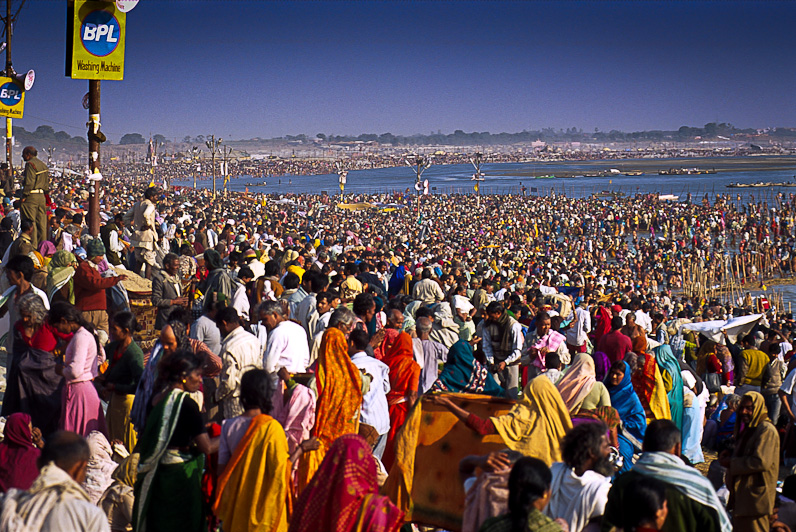
The 2013 Kumbha Mela is going to be a “Purna” or “full” Kumbh Mela which takes place only once every 12 years. I will be leading a photo workshop/expedition of just 10 participants to experience and record this epic event. Would you like to come along? I promise it’ll be an experience that you’ll never forget. This will most certainly not be a “mainstream trip”. If you decide to come along you’ll need to bring along an enthusiastic, flexible and open-minded attitude. Attending a Kumbh Mela is indeed an “immersive event”. We will dive head-first into the maelstrom of the most mesmerizing, chaotic, and photogenic event of the decade.
I’ll be mentoring each of you through the process of capturing the essence the Kumbh Mela and will assist you in the development and execution of a short multi-media story about the event. This will not be your typical photo tour, but rather like being a photojournalist, sent on assignment, to cover an unfolding story.
We already have a fairly large “interest list”, from which, chronological priority will be given. If you have not already expressed interest and you’re considering this trip, I suggest that you contact us by email as soon as possible.
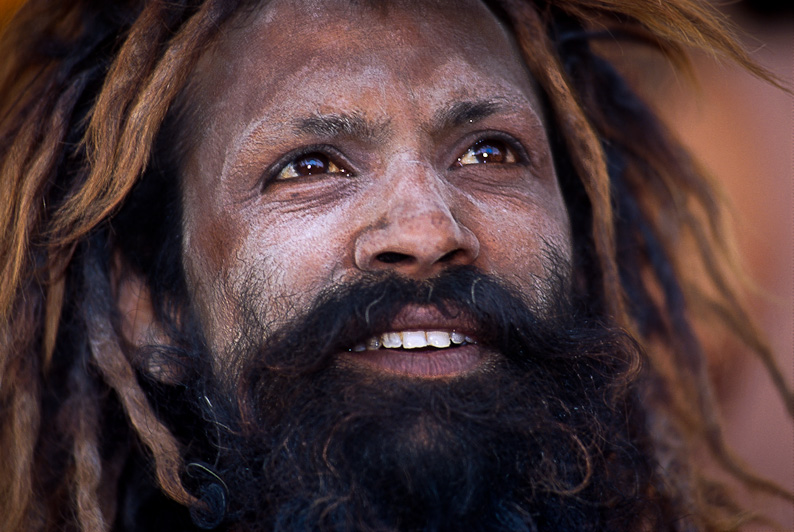
Our exact itinerary is being developed as we obtain new information from our sources in India, however I’ll share with you some basic details.
Apart from our arrival and departure hotel in Varanasi, accommodations at the Kumbh Mela will be in 14’x14′ Swiss “luxury tents” with comfortable beds, running hot and cold water and electricity. The tent city will be located within the mela grounds. This will make for easy access for photography, but difficult sleeping conditions, as there will be celebrations all night, every night. All meals will be taken at our tented camp.
We will shoot together as a group whenever possible, but staying together with the group, or staying close to me, will be your responsibility. It will be virtually impossible for me to keep track of one, much less eight participants, in a crowd of 30 million or more. We will have meals together as well as regular meetings back at the tent city as a way of keeping tabs on everyone and staying connected. Any down time we have (and there won’t be much), we will likely be working on backing up, editing images and blogging.
We will shoot the main bathing days. These will be the very crowded events and will take place the whole day starting from pre dawn to long after sunset. The great thing will be to see the various holy men taking the bath as well as the pilgrims doing it later. We will photograph the holy men bathing if possible. There will be huge crowds, we may not even be able to take vantage position for this. (we are talking about a couple of million people in a very small area!)
We’ll shoot the procession of the holymen. During the main bathing day, there are very interesting procession of the holy men who travel in chariots or walk naked through the mela. This is easier to photograph.
We will visit and photograph the temporary ashrams of the holymen. These are called Akharas and here we can get to sit with them and interact with them. These meets should take place before and after the main bathing days.
The local Indian administration will be closing all roads leading to the Mela ground one day prior to the main bathing date. So we have to arrive two days prior to the bathing date. We can leave one day after the main bathing day.

Perhaps the best way for me to convey what this incredible photographic journey will be like, is to share with you a story entitled, “Gods Gurus and the Ganges”, which I wrote back in 2001 after attending the Maha Kumbh Mela in Allahabad. I took a two-week leave of absence from my job and traveled to India; an inexperienced amateur photographer, armed with 60 rolls of Fujichrome Provia 100F slide film, and a dream, to capture on film, the once-in-a-lifetime, Maha Kumbh Mela. The trip was the final tipping point in my desire to follow my passion. A year later, almost to the day, I resigned from my corporate job and began my career as a professional photographer.
I present to you, my first ever “photo story”,
Maha Kumbh Mela 2001: Gods, Gurus and the Ganges.
Once every 12 years, millions of the world’s most zealous Hindu pilgrims gather at the confluence of the Ganges and Yamuna rivers near the city of Allahabad for the greatest of India’s immersion rituals, the Maha Kumbh Mela. This year’s Maha Kumbh Mela is particularly auspicious, being the first of the new millennium and coinciding with an astrological planetary alignment occurring only once every 144 years. By the time the 2001 Kumbh Mela ends on February 21st, approximately 70 million saints, sinners, Sadhus, faith healers, preachers, gurus, charlatans and devotees from across India and the world will have participated in perhaps the single most colossal gathering of humanity since the dawn of time.
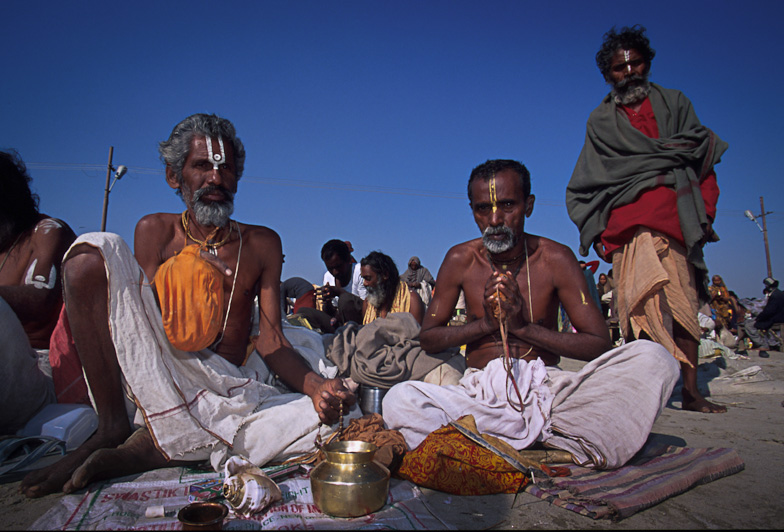
In Hindu mythology, Gods and demons fought over the pot (Kumbh) of the divine nectar of immortality. The Gods ultimately obtained the pot of nectar, spilling some back on the earth, upon four cities in northeastern India: Allahabad, Ujjain, Nasik and Haridwar. The Kumbh Mela rotates between these sites every four years. Allahabad, (the modern name of the holy city Prayag, meaning “holiest of the holy”) located at the confluence of the Ganga, and Yamuna rivers is considered the most sacred and important location for the Mela.
Hindus believe that during this year’s Kumbh Mela a bath in the Sangam (the holy confluence of the Ganga and Yamuna rivers) will cleanse them of their sins, and grant an escape from the endless cycle of reincarnation.
The Maha Kumbh Mela is truly a microcosm of Indian society at its most spectacular. The six-week spectacle is a passion filled festival, which transcends creed, caste and religion. For the throngs of Hindu devotees who will travel here it is a chance at salvation.
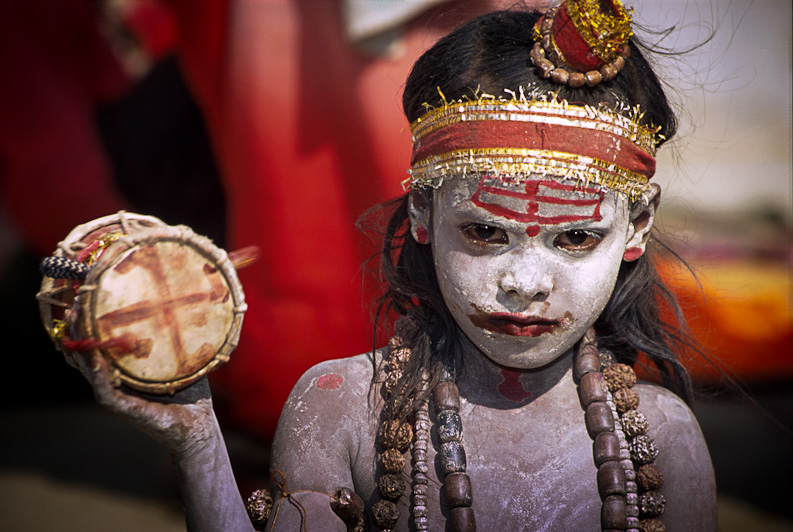
Of the 70 million or so attendees at the Kumbh, most are rural villagers and commoners who have traveled for days, weeks or even months by any means possible on a personal search for the divine. Carrying bundles of provisions on their heads, unprepared for the low temperatures, they will sleep on the open ground; eat whatever is available and brave conditions that most westerners would find unimaginable. They have come for the opportunity of a lifetime, the opportunity for a miraculous dip into the cleansingly frigid waters of the Ganges on this sacred occasion.
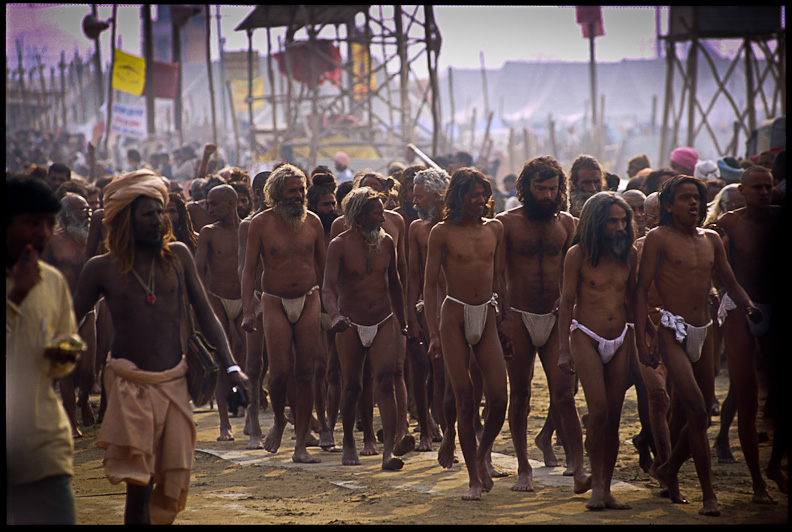
I had arrived in New Delhi on January 19th, 2001 meeting my friend from past trips, Satkamal Singh, a Sikh cab driver. We would leave the next morning for the fifteen-hour road trip to Allahabad. Acting as my translator, guide, negotiator, photographic assistant and personal security officer, Satkamal would be an integral part of my plan to chronicle the biggest Kumbh in history.
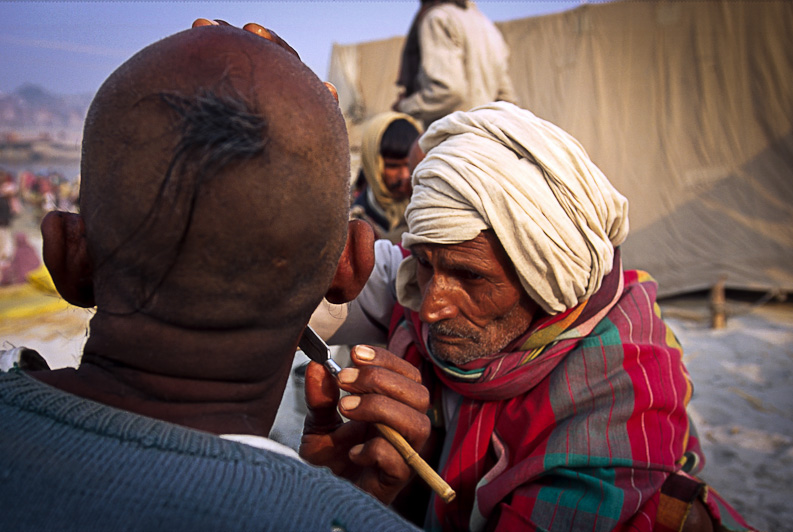
A key component of this trip was my desire to photograph Sadhus, India’s religious holy men, many of whom have decided to forgo normal life, renounce all belongings, and live nomadic or reclusive lives sustained by herbs, handouts and hashish. Protected by the armor of nakedness, the most militant of the Sadhus, the Nagas, were top on my priority list. Nagas, whose ascetic traditions date back more than 2000 years, have on occasion defended Hinduism against the fervor of a younger religion, Islam. The Nagas are considered the most Holy and revered among the Sadhu sects. The term “holy” however, can sometimes be a misnomer since India’s Sadhus are not all seekers of God. The unmistakable dress (or lack there of) does impart respect among the faithful, but it is a known fact that some Sadhus are criminals wanted by police for murders, rapes, swindling or trade in contraband and narcotics.

During my days in the Sadhu camps, I met fascinatingly bizarre characters, many of whom have taken on various penances as signs of ultimate devotion. I spent time with Amar Bharti Baba, a man who’s now petrified arm has been held aloft for the past 27 years. I met Radhey Puri Naga Baba, a man standing on one leg for nearly a decade, his feet swollen to twice their normal size. I visited the midget Sadhu, Bawan Giri Baba, a 62 year old who stands barely two feet tall. Countless others who make up the 180,000 or so Sadhus who attend the Kumbh, bury themselves in the sand, sleep on piles of thorn bushes or remain silent for years. Some are regarded as prophets, saints and gurus-others as outcasts or criminals. In my days with the Sadhus I was questioned, blessed, dismissed, and hustled. I was offered spiritual advice, tea, marijuana and hashish more times than I can count.

Apart from the Sadhu ashrams, the entire Mela grounds were a riot of sights, sounds, smells, colors and movement. Among the crowd were some 5000 barbers, on site to service the millions who elected to have their heads shaved before bathing in the Sangam. A shaved head costs around 10 Rupees (25 cents)-a small price to pay for a spiritual advantage (Hindu’s believe that each strand of hair is the equivalent of buying a cow for the God of your fancy). Shaving one’s head therefore speeds up one’s journey to heaven. Intermingled with the barbers were legions of beggars who offered yet another way to create good Karma for one’s self. I witnessed even the poorest of pilgrims filling a beggar’s extended hand with anything from a rupee to a cup of rice. Beggars in India provide a unique type of symbiotic relationship with those who are more fortunate.
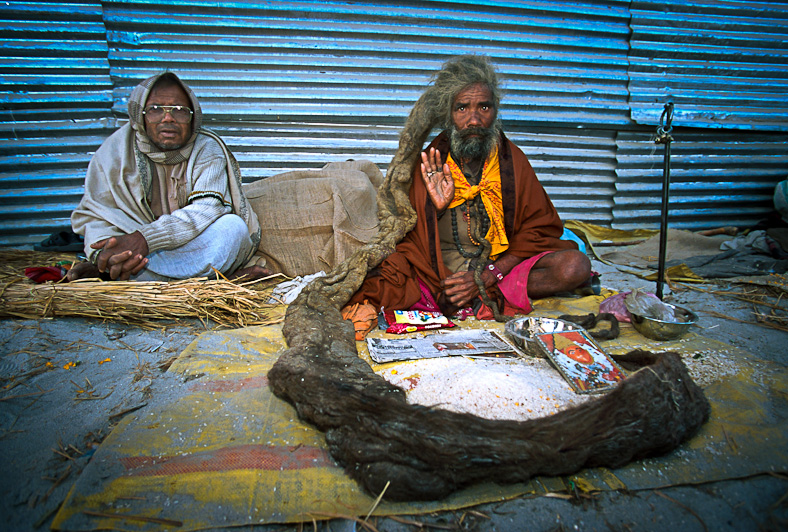
Begging allows those who are able to give, the opportunity to do a good deed. Beggars come in all types, but none were more heart wrenching than the hundreds of lepers at the Kumbh. Many were wheeled in on makeshift wooden carts or carried on the backs of family members. Almost all the lepers were covered with wool blankets, their affected limbs bandaged with hopelessly soiled rags. Partial limbs protruded from beneath blankets for all to see, many lacked fingers, toes, or entire hands and feet. The most unfortunate lepers, with advanced disease, quivered and shook uncontrollably, as if shivering, despite the stifling mid day heat. Meanwhile, just steps away, processions of gilded coaches draped in silk, announced the arrival of important religious leaders.

Competing for attention in this already deafening cacophony, were the chants of passing processions, intermingled with loudspeakers that blasted anything from religious mantras, to announcements in Hindi about cattle insurance and cigarettes. The decibel level seemed to deafen all but the most calloused Indian ears. At one point I decided to call my wife back in California, using one of the many STD phone booths set up in small shacks on the Mela grounds. STD phones, ubiquitous in India, resemble taxi-meters; an L.E.D. read-out displays the cost in Rupees as the call progresses. Once my connection was made I shouted into the receiver and struggled to hear my wife’s responses. Conversation was nearly impossible so finally; I held the phone in the air to let her experience the incredible din. As my phone bill neared two hundred Rupees, I noticed the phone booth operator grinning from ear to ear. I’m sure this was the most expensive call of the day.
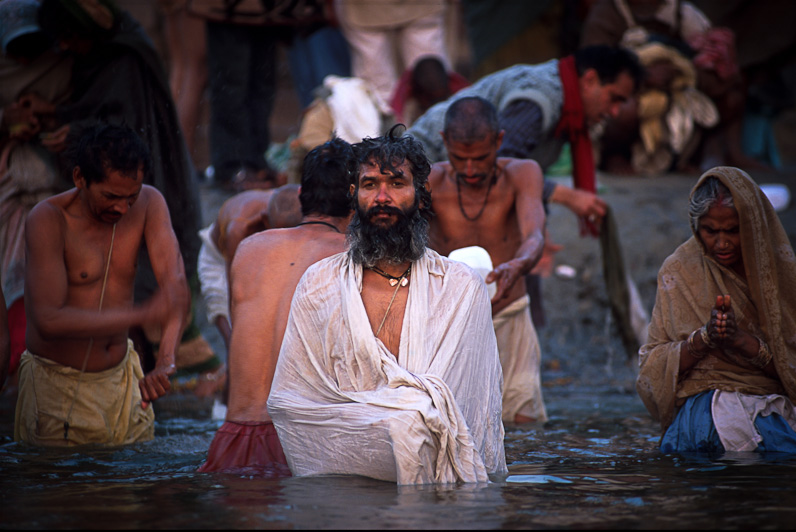
January 24th – Mauni Amavasya, the most auspicious bathing day-an estimated thirty million people would cleanse themselves in the sacred river. That day proved to be the most extraordinary day of the Mela and perhaps one of the most extraordinary days of my life. Rising at 3:00 am Satkamal and I began our journey from Allahabad town towards the fairgrounds. The sea of humanity we encountered was utterly staggering, it seemed that the world’s population was singularly headed towards the Sangam. Arriving on site we quickly realized that moving around today would be an experience all its own.
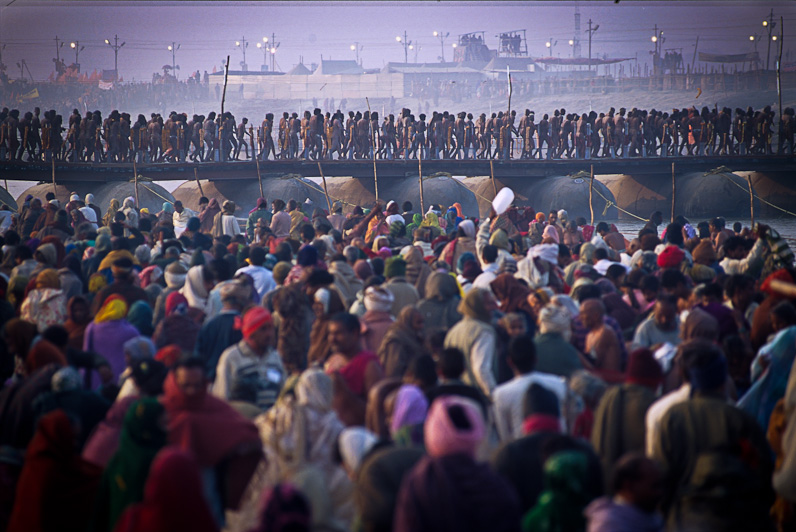
Being captured and propelled along with tens of thousands of other human beings through fenced off paths to the river was beyond imagination. Like blood cells in a vessel, those of us in the middle of this stream of humanity moved effortlessly, while those along the fence, slowed by even the slightest friction from a fencepost or other obstruction became squashed or spun like debris caught in the eddy of a flowing stream. At one point I noticed an old woman stumble. Gripped in terror she began to scream as the surging crowd, unable to stop its forward momentum, flowed onward compressing around her. Police began to furiously blow whistles and beat lathis (bamboo sticks) on baskets of provisions balanced atop people’s heads, in an attempt to draw attention and slow the onslaught. The makeshift bamboo fence, lashed together with twine, unable to contain the swelling mass, burst open. Miraculously, the old woman and those caught in the crush, spilled out a gaping hole to relative safety.
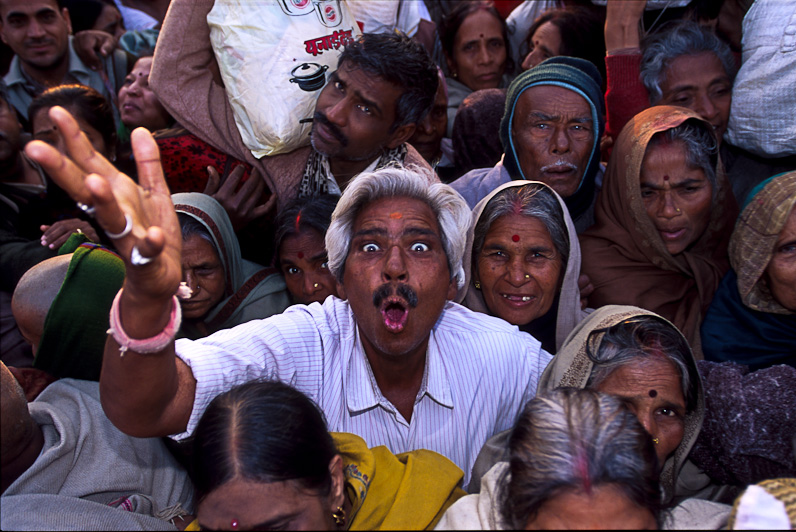
Families separated in this melee began to wail and shout as those left within the stream were helplessly propelled forward, leaving those outside the fence unable to keep pace. It occurred to me that I had just witnessed this entire sequence through the viewfinder of my camera when I reached the thirty-sixth frame. As I finally lowered the camera from my face, Satkamal was nowhere to be seen. As we surged towards the river I concentrated my attention on positioning myself to photograph the processions of Sadhus on their return from the Sangam.
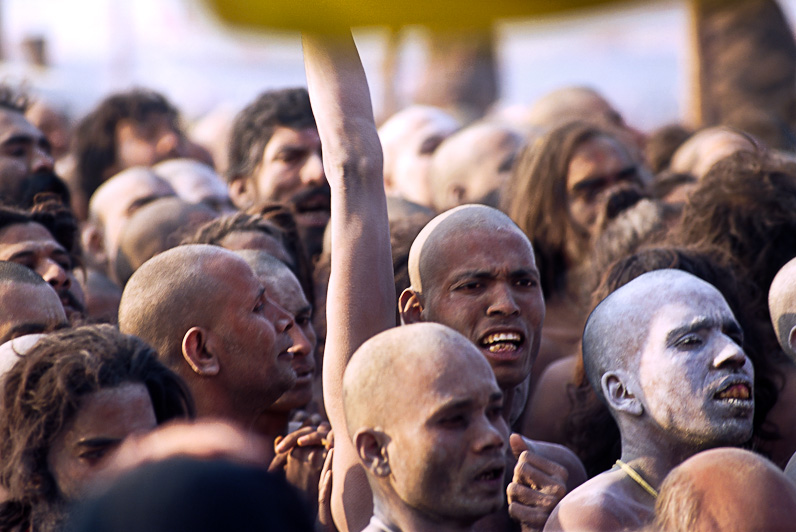
Slightly after dawn, now hopelessly separated from Satkamal, I broke ranks from the crowd, squeezed through a narrow passage between some tents and ducked under a police blockade. Suddenly, I found myself, the lone photographer, in a restricted area, staring down nearly 200 unclothed, ash-smeared, dreadlocked, Naga Sadhus, many wielding clubs, swords or tridents. Assessing my only escape route, the scaling of an eight-foot high bamboo fence, followed by a leap into the throng below-my adrenaline surged. My mind raced with the prior day’s report of an unfortunate photographer, whose camera was smashed by angry Sadhus and a police attack that left six journalists hospitalized. At this point I had a decision to make- to shoot or not to shoot. I decided to stand my ground, after all I had come halfway around the world to capture these images and this opportunity would not present itself again for another 144 years. I scanned the crowd of naked revelers searching for a familiar or friendly face but to no avail.
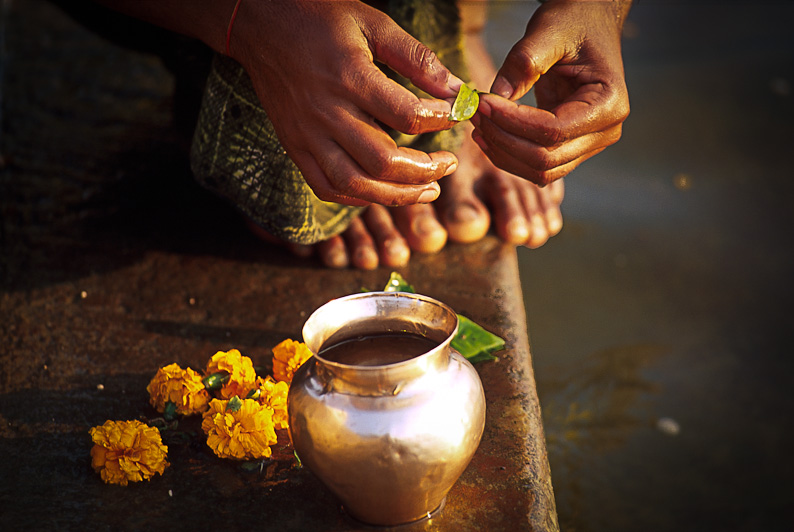
Motioning with my camera to one of the friendlier looking Sadhus, I received the typical Indian nod of the head, signaling that it was ok to start shooting. As I lifted my camera, a police officer, under orders to restrict photography of women bathers and naked Sadhus, instructed me in Hindi and unmistakable sign language, to put the camera down. Unfortunately, Satkamal was not here to help me negotiate a bakshish (bribe). My heart sank thinking that I might miss the shot, but today the Gods were smiling on me, a disturbance broke out about fifty feet away and the police left to investigate. The opportunity to start photographing began just as the procession of Sadhus started to move forward. Juggling two cameras I was able to snap off about forty frames of the naked Nagas. Almost as quickly as it began, the Nagas were gone. Exhausted yet exhilarated, I was pleased to notice that I had survived, unharmed. I unloaded the two canisters of exposed film and quickly stashed them deep in by breast pocket.
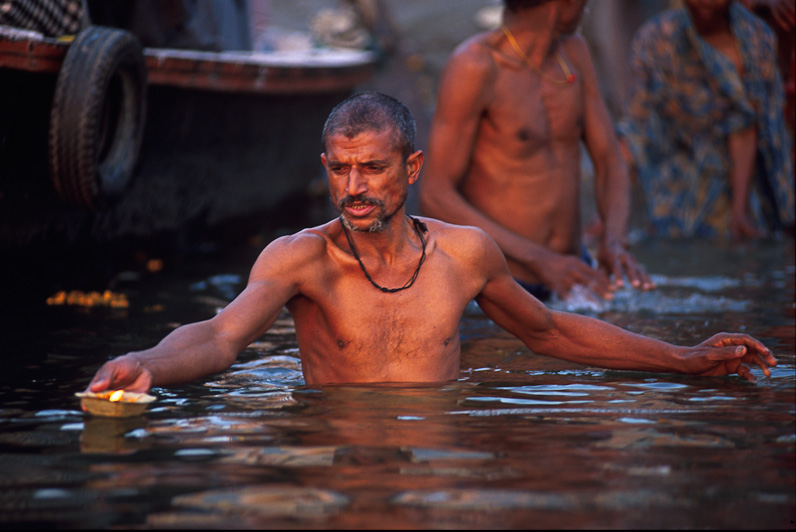
This year’s Kumbh (2001) was one of the most organized ever. Authorities spent millions on planning, infrastructure, logistics and security. In preparation for the gathering, orders for 13,000 tons of flour, 7,800 tons of rice and 5,000 tons of sugar were placed. 20,000 latrines were constructed. Fifteen temporary pontoon bridges were placed to span the river, complete with repair crews who constantly rebuilt sections of the bridges damaged by the staggering foot traffic. Five computer centers, a plethora of outdoor movie theaters, six petrol stations, countless tea shops, ashrams and dining facilities rounded out the 18 square mile temporary tent city that had sprung up on the dusty riverbed. Some 20,000 police were deployed along with navy divers, mine sweepers and bomb sniffing dogs. On January 24th, Mela officials reported 30,000 people lost or separated from their families.
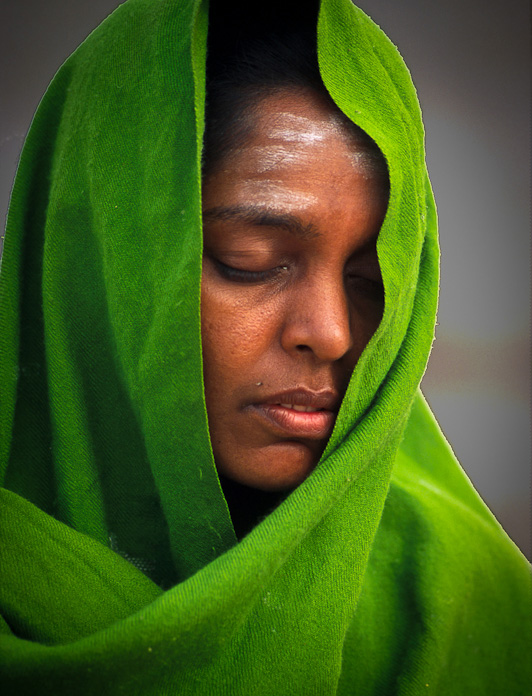
Using the worlds largest public address system, the Mela’s lost and found centers set up at strategic locations all over the fairgrounds attempted to reunite disconnected families. Despite a history of deadly stampedes at the Kumbh which killed 500-1000 people in 1954 and another 60 people in 1989, along with disturbing reports of possible terrorist attacks-VIP’s including the Dalai Lama and Sonia Gandhi were in attendance.
After 14 hours of intense shooting, with my precious film safely tucked away, I decided to start back towards Allahabad. Crossing the river to town using the pontoon bridges turned out to be impossible. I made two attempts but gave up after more than an hour, having made little or no progress trying to enter the huge funnels of people.

While aborting my second bridge crossing attempt, I felt someone gently take my hand. I looked down expecting to see a child but saw a visibly frightened, frail looking, elderly woman, no more than five feet tall. With tears welling in her eyes, she explained to me that the day before, she had witnessed two women nearly crushed to death in a similar situation near the river. Too short to see which way to get out, she asked if I would help her escape the deluge, I said that I would. With a vise-like grip on each other’s arms, I pulled her along behind me. Using a technique similar to exiting a rip-current at the beach, we moved at an angle slightly oblique to the direction of flow. After a long fifteen minute struggle, covering little more than fifty yards, I was able to dislodge her from the tightly compressed crowd. Free of the flow and sweating profusely, she hugged me and we parted company.
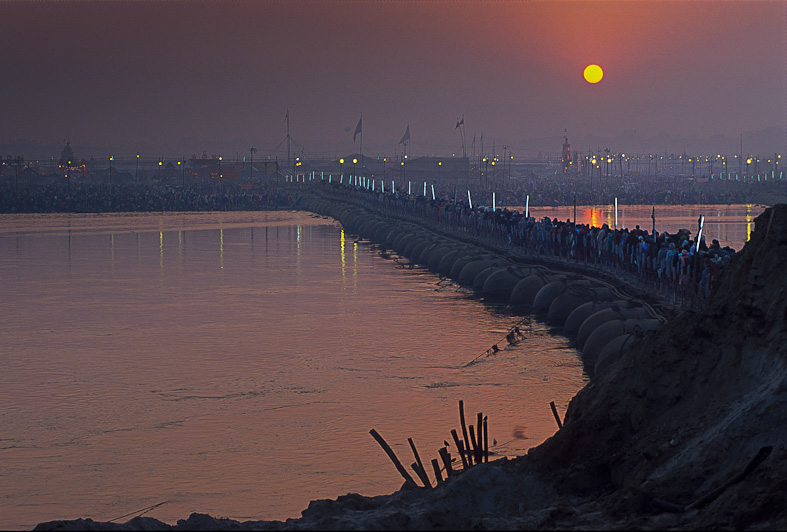
Finding no other way back to Allahabad, but to circumvent the pontoon bridges, I reluctantly decided on a lengthy five mile detour back across the Mela grounds and over a traffic bridge. It seemed that several million people all had the same idea, but at least we were moving forward. Once on top of the bridge, the aerial view afforded a different and unique perspective of the enormity of the Kumbh Mela below. I took the opportunity to stop and make several photographs, then moved on.
Slightly after dark, I finally arrived back in Allahabad. Satkamal, who had expected to see me hours before, looked relieved as I walked through the door to our hotel room. Later that evening we compared notes over a typical meal of curry fried rice and basked in the collective excitement of that epic day.
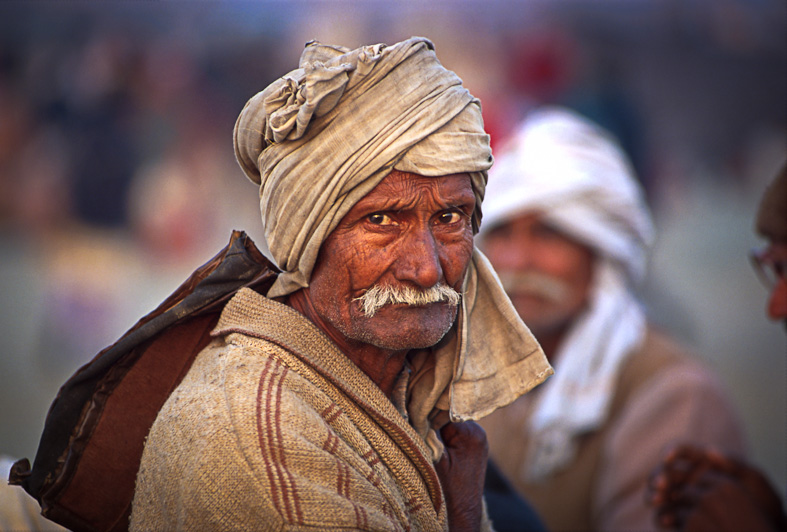
Ten days later, while flying back to Los Angeles, I reflected on this, my third and perhaps most fascinating visit to India. I had left home three weeks prior, thinking I would learn about India and returned, having learned a great deal about myself. India has once again presented me with new questions, knowledge and perspectives which I will likely ponder for months.
Of my experiences at the Maha Kumbh Mela, I will not only remember the massive crowds, the exotic and bizarre Sadhus, the flamboyant gilded processions of saints and the helpless lepers, but also the kind, gentle, friendly Hindu pilgrims with whom I had an opportunity to share the climax of perhaps the world’s most colossal spiritual event.
Still interested in coming along for the 2013 Kumbh Mela? See the details at www.jimclinephotoworkshops.com


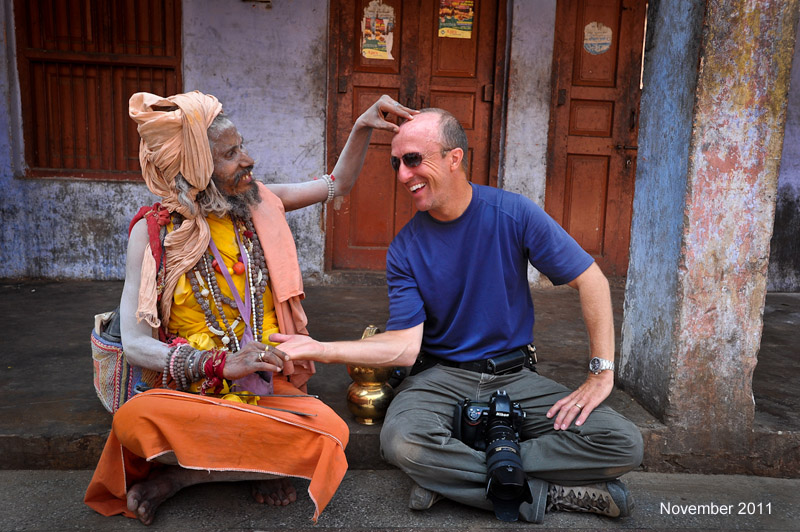






I really enjoyed reading this post, Karl – and the photography is stunning. Thanks for an insight into another world.
Wow.. quite a story. As a very petite woman, my biggest fear is being trampled in a crowd like that, but it sounds like quite a trip.
Interesting to see how amazing your photography has become since your start!
Amazing, amazing Karl….my trip list is getting longer and longer…..
WoW!!!
I attended the Kumbh Mela in Haridwar three years ago. I got some amazing photos (not like these, Karl – I say again WoW!) and had an un-repeatable experience. I’d love to do it again…
One day…
wow again. The pictures and words kept me wanting more. A lifetime experience!! Wish I was up to it but should pass. But look forward to experiencing the camel fair in November. janet
Thanks to Ian, Susan, Patsy, Ursula and Janet, I really appreciate you all taking the time to comment here. The 2001 Kumbh Mela was something I’ll never forget and I am sure that you have also had experiences in your travels that are forever burned into your memory. We’re a very small and fortunate percentage of the world’s population, who have the opportunity to experience and enjoy these types of places and events. I try to never loose sight of that fact that I (we) are very lucky and that life is good. Cheers, Karl
first of all WOW… amazing photographs…
I was doing my Masters in 2001 my collage is very near to Mela area. Few of my exam paper were postponed because of that…
Being from Allahabad I have a lot of memories of Kumbh Mela… my grand parents use to stay there for Kalpvaas (holy stay) for this month which starts from 14 Jan (Mankar Sankrinti) and end at Basant Panchami. During this time they should take bath before sunrise in Sangam daily, can eat one meal a day and spent rest of time praying to God and other spiritual discussions. Staying in camp and sleeping on straw in chilling winter, bonfire, eating boiled potatoes are some memories for life time… I still still can listen sound of those loudspeakers and sense smell of bleaching powder…
Not sure if I will be able to make it in 2013, but if you are going to cover Kumbh Mela, try to live as Kalpvaasi’s do. It will be an experience for sure… 🙂
Best Wishes
Thanks Pawan, It was fantastic to hear of your experiences and insights! …and thanks also for the nice compliment. Take care and happy shooting! Karl
Karl, your work is fascinating. I am proud of you as a friend and fellow Benet Grad.
I hope to see you again someday. You’re very kind. Allison
Amazing photos. The masses of people are simply overwhelming! I’m wondering how you managed to take pictures amongst all that. I feel so close to the people you captured with your lens, but where were you standing…or is that giving away trade secrets? 😉
Dear Fellow earth Citizen Karl, really this work is a master piece, these photographs say million words and million more to think about. Although being born and brought in India the country still is a mystery for me, I traveled extensively through out the country with my father as we both have intense interest in understanding the philosophy behind renouncing every worldly desire for seek of higher peace. Although the path to truth has been extensively described in Vedas, Upnishads, Bhagwat Gita and 100s of other philosophical master work but still it has to be acquired by self exploration. Your photographs takes me to those memory lanes. Allahabad (Prayag) and Varanasi are two most mystical town for me, no matter how many times I go there, each time I find more intense spiritual bonding.
I am also trying to learn to shoot.
Thank you once again for the photos and the story.
Hey I will be interested. Please let me know how to contact.
– Sunny
earthsucks@gmail.com
Hey Karl ……i am speechless to see your work every picture of your’s tells a different story being a native of Allahabad it’s a pleasure for me to see such astoundingly amazing clicks of Holy festival ………hope to meet you there at Maha kumbh 2013 at Allahabad it would be my pleasure 🙂